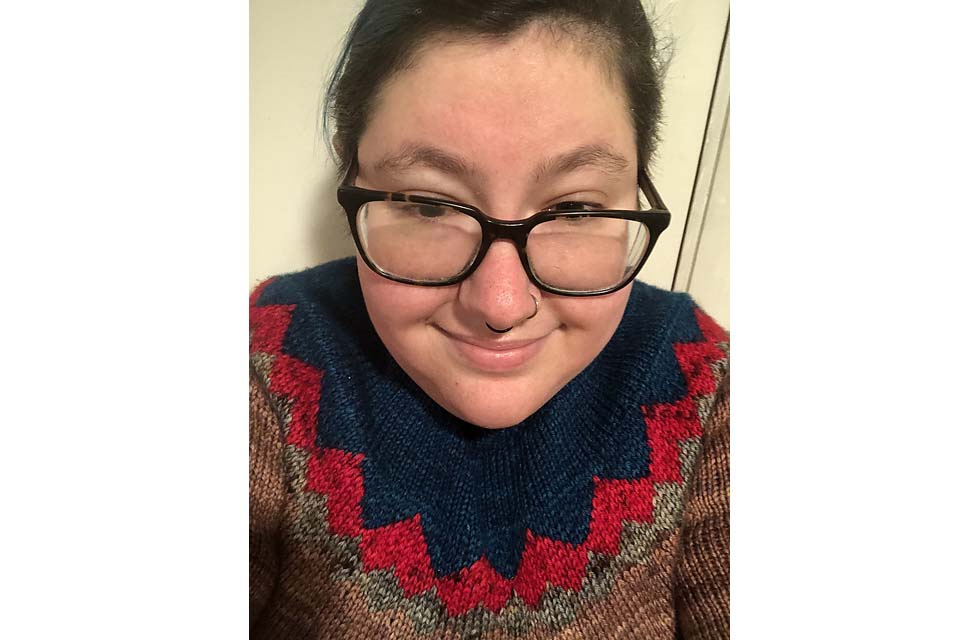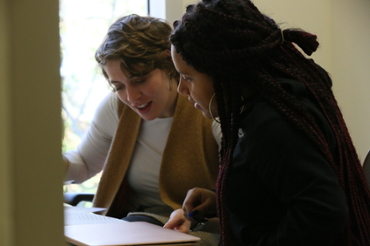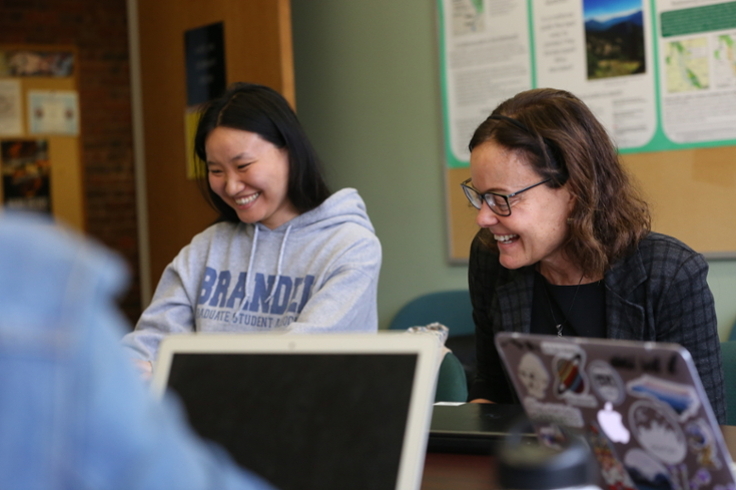Geeking Out With...Cat Rosch

April 2, 2025
Abigail Arnold | Graduate School of Arts and Sciences
Geeking Out With…is a feature in which we talk to GSAS students about their passions. You can check out past installments here.
Cat Rosch is a third-year PhD student in History. She researches the ways in which Massachusetts college women used birth control and abortion activism to create political identities in the 1960s and 1970s. They joined Geeking Out With…to talk about their passion for knitting and dyeing yarn.
This interview has been edited for clarity.
How did you get into knitting?
I got into knitting around 2018. I was working at a job that required me to be on the phone a lot, and I realized that I was getting really antsy and needed something to do with my hands. A friend who knitted took me to the yarn store with her, and I bought some needles and cheap yarn and made a scarf. I thought it was awesome, so I got really into knitting and started making more things.
What are your favorite things to make?
I really like making socks. I always have at least one pair of socks going at any given time – right now I have two. I start wearing them as soon as it’s not boiling hot outside. I also like making hats. Socks and hats are nice because they are small projects that I can do on the train. I’ve made a few sweaters, but those take a couple of months and a lot of yarn. [Cat knit the sweater in the picture above.]
How did you get started with dyeing your own yarn, and what do you like about that?
I started playing around with dyeing yarn right before the pandemic. You can use stuff you have in your kitchen, like coffee and tea, to make dye. I started with Kool-Aid packets and dyed white yarn in a pot on my stove. Then I started learning more about acid dyes and making more colors. I haven’t done as much dyeing recently because of work, but it’s very cool to pick colors, make your own yarn, and make something out of it with your own two hands.
I also sell the yarn that I dye. I’ve made colors inspired by Boston, by being a grad student, by historical events because I’m a history nerd: anything that inspires me, I turn into a color combination. Since I work a lot with primary sources, I made a mini collection of light brown old envelope colors. When I was in my master’s program and was grading a lot of blue books with a red pen, I made colors inspired by that. For Boston, I made orange and brown, inspired by Dunkin’, and a red color that reminded me of a Red Sox hat I have. I also saw a really beautiful turquoise and yellow house once when I was walking on a sunny Sunday and made colors inspired by that.
How has your experience as a knitter evolved since you started?
I’ve learned that the knitting community is a very interesting community to be part of. I think there’s an assumption that knitters are old ladies and crazy cat ladies (and I am a crazy cat lady), but there are a lot of millennials and Gen Z-ers who knit. People also see knitting as conservative, but the knitting world is a very feminist, political, and queer space, which I did not expect when I first got into it! In discussing knitting, we look at the question of what gets valued as art, which I find very interesting as a feminist and historian.
How does being part of a knitting community enhance your experience?
It’s a great way to make friends – I moved to Worcester this summer and made friends here by Googling “Worcester knitting group” and joining a group I found. We hang out for a few hours every Sunday, chat, and make warm cozy things for the winter. I’m also part of a couple of online knitting groups that formed during the pandemic, so I know people across the country and world who are very passionate about it. If you go online and ask for knitting advice, you’ll get it really quickly. One of my friends found a Danish pattern and was struggling to read it, so she went online and asked for advice and eight people responded. You can meet people you would never meet in real life and help them. You can also learn things from people you meet in person – people have taught me some knitting techniques I never would have learned otherwise.
How does knitting and dyeing yarn help you deal with the stress of grad school?
It really calms me down and helps me relax. When I get stressed and antsy and need to do stuff with my hands, it helps, and it helps me take a break from thinking about my work while commuting. When I was grading midterms last week, I said I would grade a certain number, then take a fifteen-minute knitting break; when I was reading for my comprehensive exams, I also planned in knitting breaks. It’s very mindless for me, which is nice – until it’s a stressful pattern or I make a mistake, and then I’m yelling at it! I think there are a lot of grad students who knit but think no one else does. There are dozens of us!
When you’re not working on your research or knitting, what else do you like to do?
At Brandeis, I’m a union steward. Off-campus, I’m a scuba diver, although I haven’t been diving in a while. I bake and have a sourdough starter that I began pre-pandemic, so I did that before it was cool! I also like reading, music, and playing with my cat, who likes to participate in Zoom calls.
What advice do you have for other students exploring their passions?
A big thing for me is that you have to give yourself time to do things you enjoy, even if it’s fifteen minutes a day on your train ride home. Graduate school is very stressful, and obviously you have to do your research, but you can’t be writing papers 24/7. I think it’s very important for everyone in grad school to have a non-academic hobby that gets you out of that mindset a little. It’s good to have that external community and external passion as well.






